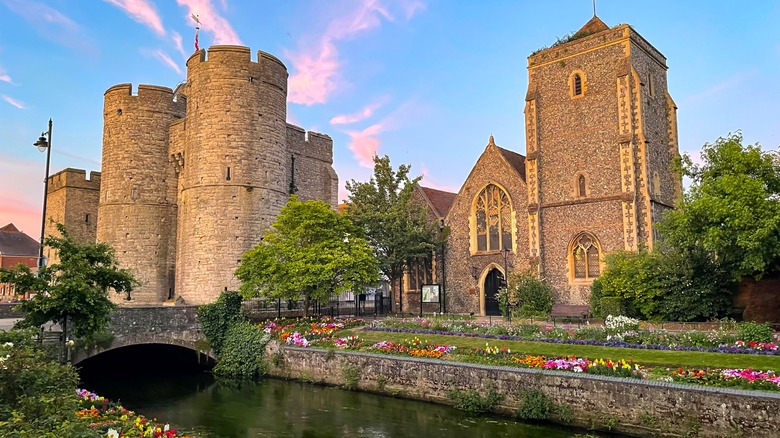This Historic City With Unparalleled Architecture Is An Easy Day Trip From London
You don't need to go far to avoid London's crowds. Just an hour's train journey away is Canterbury, one of England's most historic cities. Prehistoric Britons occupied the area before the Romans built a town they named Durovernum Cantiacorum around 110-120 C.E. Over 400 years later, in the late sixth century, the Anglo-Saxons occupied the city – which they called Cantwara-burh — and built it into a Christian stronghold. By the Norman Conquests of 1066, Cantawara-burh had become Canterbury, and the new Norman rulers took the defeated settlement and turned it into a cathedral city known to pilgrims around the world.
Today, Canterbury is a charming small city with over 1,000 years of castles, walls, chapels, and abbeys. Built into the structures of oak and flint are dozens of pubs, restaurants, and shops where one can enjoy everything from roast beef and real ale to English sweets, vintage clothes, and antique books in the famous Crooked House. There are entirely modern amenities, too, such as Marlowe Theatre and the Spitfire cricket ground. The city is also a short drive from the Kent coast and the old fishing town of Whitstable, famous for its oysters and stylish boutiques and eateries.
History and heritage in England's Anglican city
Canterbury Cathedral is home to the Archbishop of Canterbury, the head of the Church of England, and the Anglican faith. Unlike other cathedrals in the United Kingdom and wider Europe, Canterbury Cathedral has a £17 entry fee. However, if you want to experience the cathedral without the cost and the crowds, consider attending a service for free — don't forget your hymn voice.
Canterbury may be a center of God and architectural beauty, but the city's past was full of Medieval nastiness. The best man to tell you about this is John Hippisley, Canterbury's leading ghost hunter. Dressed in a gown and top hat, Hippisley is an eccentric fellow teeming with knowledge about the darkness that lurks in Canterbury's every nook and cranny, from morbid wood carvings to the harrowing story of Abigail, the scorned woman whose spirit lingers in Hawks Lane. Expect a bellowing collection of facts, humor, and a few jumps!
Cream tea, real ale, and a trip to the seaside
Canterbury excels at the traditional English experience, namely the age-old delicacy of afternoon tea. Traditional English afternoon tea pairs freshly brewed tea (Ceylon, Earl Grey) with a tiered platter of sandwiches (cucumber, ham, salmon, egg salad) and warm scones topped with jam and clotted cream. The best Canterbury venues for this include the Moat Tea Rooms, Tiny Tim's Tearoom, and the Abode Hotel.
For another distinctly English beverage, visit historic pubs such as the Thomas Becket, the New Inn, and the Bell & Crown. Each of these pubs serves a rotation of English ales — bitter, stout, porter, IPA — and features in the Campaign for Real Ale's Good Beer Guide, published annually. For craft beer, drop by the Foundry Brew Pub, where you'll meet friendly, informed staff serving delicious beer and hearty pub grub.
Canterbury is also a fine town for seafood, but if you want it even fresher, head seven miles north to the small fishing town of Whitstable, a stylish fishing town on Britain's beautiful coastline. Quaint and colorful, Whitstable is known for boutiques, art galleries, oyster bars, beach huts, and its view out to sea and the WWII-era Whitstable Sea Forts.


